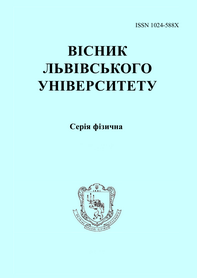DOI: https://doi.org/10.30970/vph.60.2023.183
Effects of the anharmonicity of the current-phase relation on the dynamics of fluxons in a long Josephson junction
À. Shutovskyi, M. Skipalskiy, V. Nahod, O. Zamurujeva

| Visnyk of the Lviv University. Series Physics
60 (2023) ñ. 183-195
DOI: https://doi.org/10.30970/vph.60.2023.183 Effects of the anharmonicity of the current-phase relation on the dynamics of fluxons in a long Josephson junctionÀ. Shutovskyi, M. Skipalskiy, V. Nahod, O. Zamurujeva |  |
(íå ìåíøå 1800 çíàê³â) The influence of anharmonicity in the current-phase relation on the dynamics of fluxons in tunnel Josephson junction for the temperature region close to the critical one is theoretically investigated. The modified sine-Gordon equation that describes the fluxon dynamics in the long Josephson junctions with the nontrivial current-phase relation is derived. This relation originates because the depairing effects are taken into account. The dimensionless parameter \displaystyle\varepsilon measures the deviation from the standard sinusoidal current-phase relation. This parameter is related to the transmission coefficient through the insulating barrier, \displaystyle\mathcal{D}. The presented second order partial differential equation is reduced to the first order ordinary differential equation with respect to the new space variable, because a general solution to the modified sine-Gordon equation is considered to be the traveling wave solution that propagates with the constant dimensionless velocity. The numerical methods are used to analyze the spatial behavior of the dimensionless magnetic field, because it is impossible to solve the problem for arbitrary values of the dielectric layer transparency. This have been done for several values of \varepsilon that include the extreme values and the intermediate ones. The analytical results can be obtained in the case of infinitesimal dielectric layer transparency. In this case the the modified sine-Gordon equation can be simplified. If only the lowest order of \varepsilon is taken into account we end up with the standard sine-Gordon equation. The numerical analysis allows us to make several conclusions. As the parameter \varepsilon, which measures the deviation of the current-phase relation from the sinusoidal form, grows the approximate width of the fluxon increases. This increase is well seen in the limit \varepsilon\rightarrow 1 but is insignificant otherwise. Significant departure from the sinusoidal law makes the fluxon borders more sharp. In particular, the phase distribution for \displaystyle\varepsilon\lesssim1 is almost linear in the fluxon core. The magnetic field distribution in the limit \varepsilon\rightarrow 1 is more box-like. For small and intermediate values of \varepsilon the fluxon borders are rather blurred. At the same time the maximal value of the penetrated magnetic field decreases.